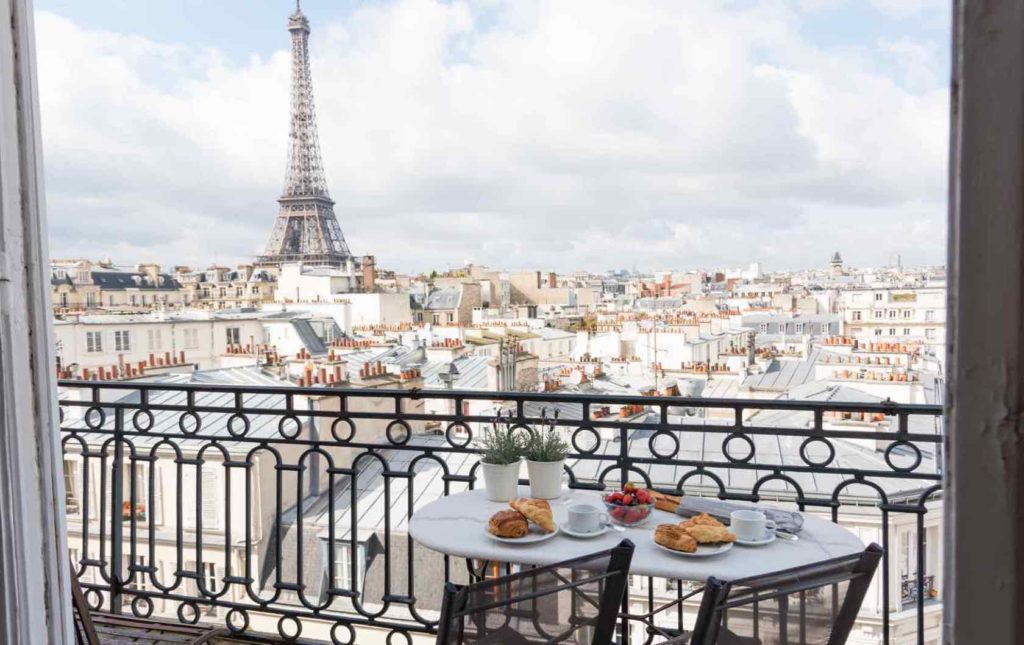If you only have one day in the City of Lights, this is how to spend it. Roll up your sleeves and prepare to dive into a world of art, culture, haute couture, haute cuisine, avante garde, and several other combinations of sleek French words that have transitioned into English.
The metro system may not be as beautiful underground as its Art Deco street signs suggest but it’s fast, efficient, and easy to use. For most of the main sights, you won’t need it anyway. With some energy and a comfy pair of shoes, you can stroll along the banks of the Seine instead.
The French capital is an incredible city – we’ll show you how to enjoy your first 24 hours in Paris.
24 hours in Paris
9 a.m. Embrace art, history and your inner Da Vinci Code all at once by visiting the world famous Louvre Museum. Head here first to (try) to avoid the crowds – and book tickets in advance. Those glass pyramids caused outrage at the time but now they’re viewed fondly as the gatekeepers to some of art’s most famous works. Don’t miss the Mona Lisa and the Venus de Milo.
Metro lines 1 and 7 stop at Palais Royal/Musée Royal.
11 a.m. Walk through the Gardens of the Tuileries to arrive at Place de la Concorde and the Obelisk. It’s picturesque today but Marie Antoniette, and many others, faced the guillotine here during the French Revolution.
12 noon. Continue along the tree-lined Champs-Elysées for a spot of window-shopping.When it comes to lunch, duck into one of the side streets to protect your wallet and find a charismatic zinc café bistro for wine, onion soup, and a crusty baguette.
2 p.m. At the end of the Champs-Elysées climb the stairs (or take the elevator) to the top of the Arc de Triomphe. Napoleon commissioned this arch to honour the soldiers of France. Today, a flame burns beside the Tomb of the Unknown Soldier, a tribute to all those lost in battle.

From the roof, the Arc offers a fantastic view of Paris. You’ll glance back along the Champs-Elysées, north tothe dome of the Sacré-Coeur, then west to the cube shaped structure at La Defense. And, of course, there’s the unmistakable outline of the Eiffel tower close by.
3 p.m. You’ll find the next iconic viewpoint by the fountains of the Trocadero, which you can walk to if you’re feeling sprightly. If not, give in and take the metro. Looking back at you from across the River Seine is the wiry spindly shape of the Tour d’Eiffel.
Metro Trocadero lies at the intersection between Metro lines 6 and 9.
4 p.m. Puff your way up the stairs (or else brave more queues for the elevator) of the Eiffel Tower. You can educate yourself on its 19th century engineering history as you go – like the Louvre, no-one was too happy when it was built. In winter, you’ll catch the sunset, in summer the scent of the city. At any time of year, it makes sense to book tickets in advance.
5 p.m. It’s a long walk east along the banks of the Seine to Notre Dame so here’s another point where you may prefer to take the metro. This behemoth of a cathedral has seen plenty over the years. There’s been a marriage that sparked a massacre in 1572 and, oddly enough, the coronation of Henry VI of England. Look out for the impressive stained glass windows and Gothic flying buttresses, then listen out for the whispers of tourists calling out the name “Esmeralda!”

RER Lines B & C and metro line 4 stop at Saint Michel. Metro lines 1 & 11 stop at Hôtel de Ville, line 10 at Cluny-La Sorbonne and 7, 11 & 14 at Châtelet.
7 p.m. For your first evening in Paris, leave the river behind and head to the narrow cobbled streets of Montmartre. Here you’ll find the elegant Sacré-Coeur and its flurry of steps that overlook the Paris skyline. You’ll also find France’s smallest vineyard near quaint cabaret Lapin Agile. And if you stumble just beyond the edge of Montmartre, you’ll see the scarlet windmills of the notorious (and slightly seedy) Moulin Rouge.
Metro stop Blanche on line 2 for the Moulin Rouge. For the Sacré-Coeur, use either line 12 to Abbesses, line 2 to Anvers or line 12 to Lamarck Caulaincourt.
Reaching Paris
As you might expect, Paris is well connected to the rest of France. The fast TGV trains make crossing the country a speedy affair. You’ll need to make a reservation for many of the fast services, though. You’ll also need to pay attention as to which of the main stations you’ll arrive in.
Paris Gare du Nord is the main station. It receives the Eurostar service from Britain as well as trains from Belgium and the Netherlands and the shuttles from airport Paris Charles de Gaulles. The main stations have every facility you’d expect, from luggage lockers to cafes and information desks.

